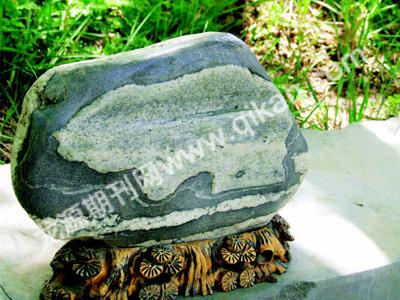Boulders of the Yellow River
2009-04-30DouXian
Dou Xian

The Yellow River, a major cradle of the Chinese civilization, surges through Qinghai, crosses the northern China before it empties into the sea in Shandong Province. Among other things, the river is strewn with boulders in many sections. The best boulders are in Guide, Qinghai Province, in the upstream Yellow River.
The river surges and splashes into Guide County through the narrow and steep Longyang Gorge and roars its way out of the county through the Songba Gorge. In sharp contrast, the section identified by the two gorges at the either end is serene. The river meanders unhurriedly across a wide plain, its limpid water sparkling on a find day in light greens and blues under the overarching sky, its riverbed strewn with colorful pebbles.
The river brings an outstanding feature to Guide. The county has the boulders better than any in other sections of the river. In a course of millions of years, the powerful waters of the Yellow River in its upstream have cut deep gorges through mountains and brought numerous huge boulders to the flatland of Guide. These boulders take strange shapes and vary in size and weight. Many of them are huge. They are grotesque in shape. They present naturally vivid images on their rocky surfaces as if they were paintings created by artists.
And Guide is proud of the godsend rocks. The county square proudly displays a huge boulder in its center. It weighs 20 tons and its surface presents a natural painting of the sunrise over the sea. A large compound in Gejiar Village in Hexi Town is home to hundreds of such boulders. One boulder presents a black yak trekking lonely in wilderness, its horns showing its wild force and determination. Another boulder illustrates, in flowing lines, how the Yellow River plunges down from the heaven as poeticized in a Tang poem, depicting a range of snow-capped mountains and valleys. Another boulder in golden tints portrays the widespread loess plateaus which give the defining color to the great river. One boulder depicts how the Yellow River empties into the sea in the east, illustrating how the river and numerous small rivers converge and empty into the sea.
Some boulders dont present pictures. They feature strange remarkable shapes. One boulder resembles a book, aptly entitled “A Tale of Stone in Heavenly Script”.Another resembles a giant panda holding two bamboos. Yet another looks like a dancing Tibetan girl.
Though the compound holds thousands of boulders, many houses in the county have their own boulders around their houses.

Some boulders become monuments. A rock on a mountain slope near the Yellow River looks like a pagoda. A local folk story relates that a Buddhist named Master Lotus and a boy servant came to tame the floods of the Yellow River in this part of the wilderness. The master cited a sutra and conducted a ritual. The Western Mountain split and created a route for the river to flow eastward. With the floods brought under control, the master and his disciple decided to have a break. They sat down and leaned against a huge roc. The impressions of their backs on the rock can be seen even today. On the 15th day of the seventh month on the lunar calendar, local people hold a ritual here in honor of Master Lotus. Another rock by Arhat Village resembles a stone sculpture of a giant frog, ready to jump at any moment. Local legends say that it was set up by ancestors in very ancient times to prevent hails from damaging crops. One boulder has the vivid images of footsteps presumably left over by the horse ridden by King Gesar. One boulder presents an image of Buddha Maitreya. These images and concomitant folk interpretations reflect the local history, faith, evolution. □
